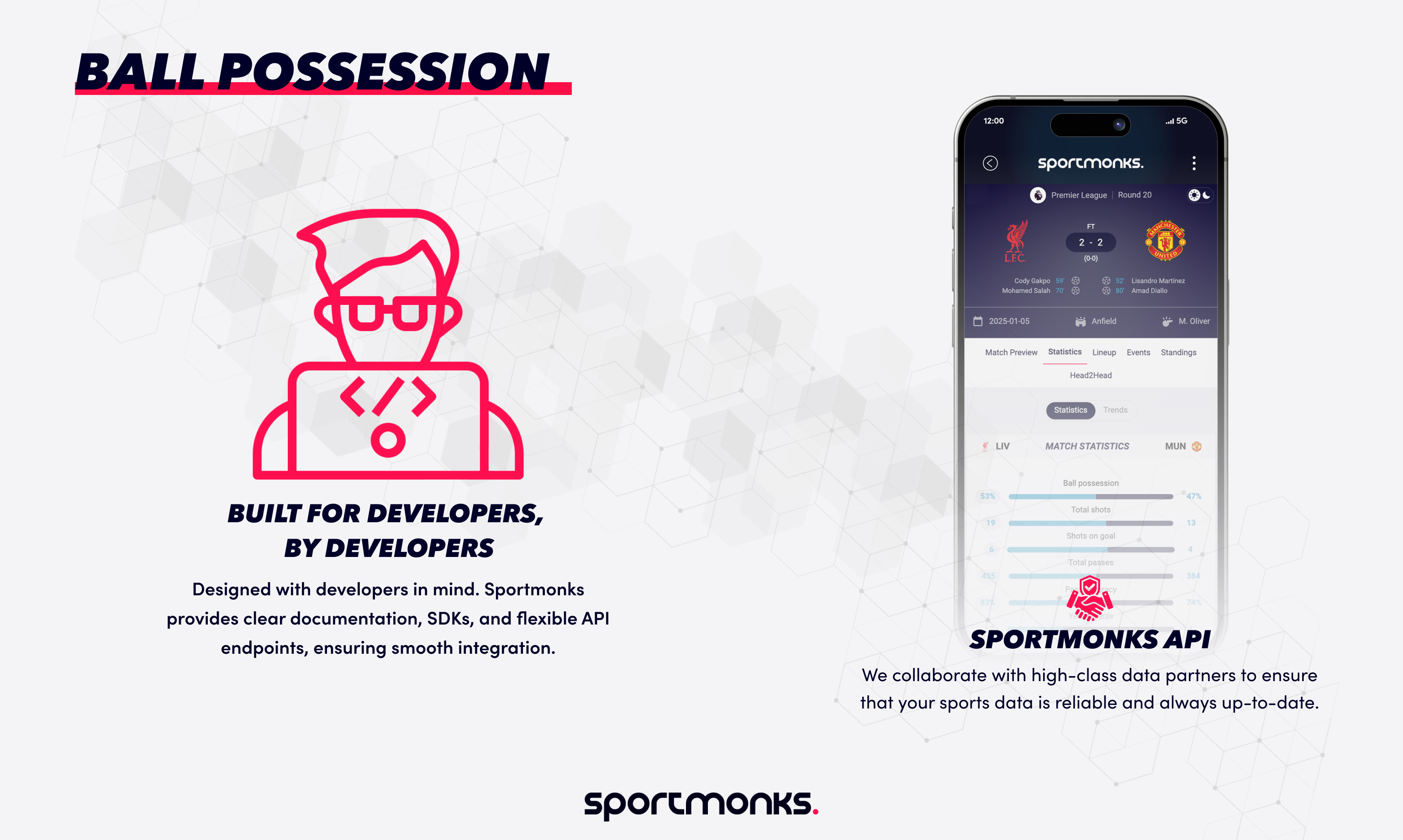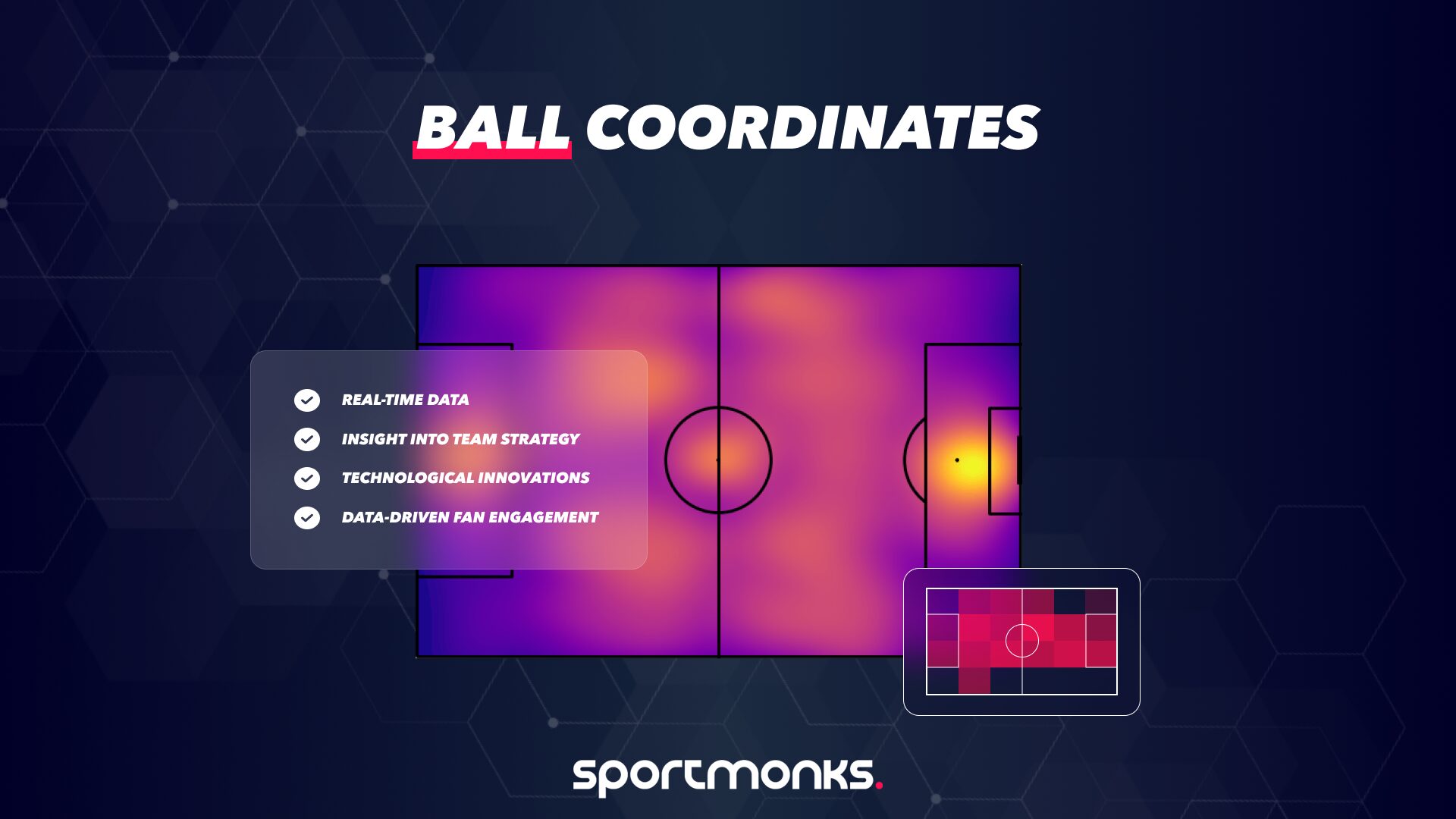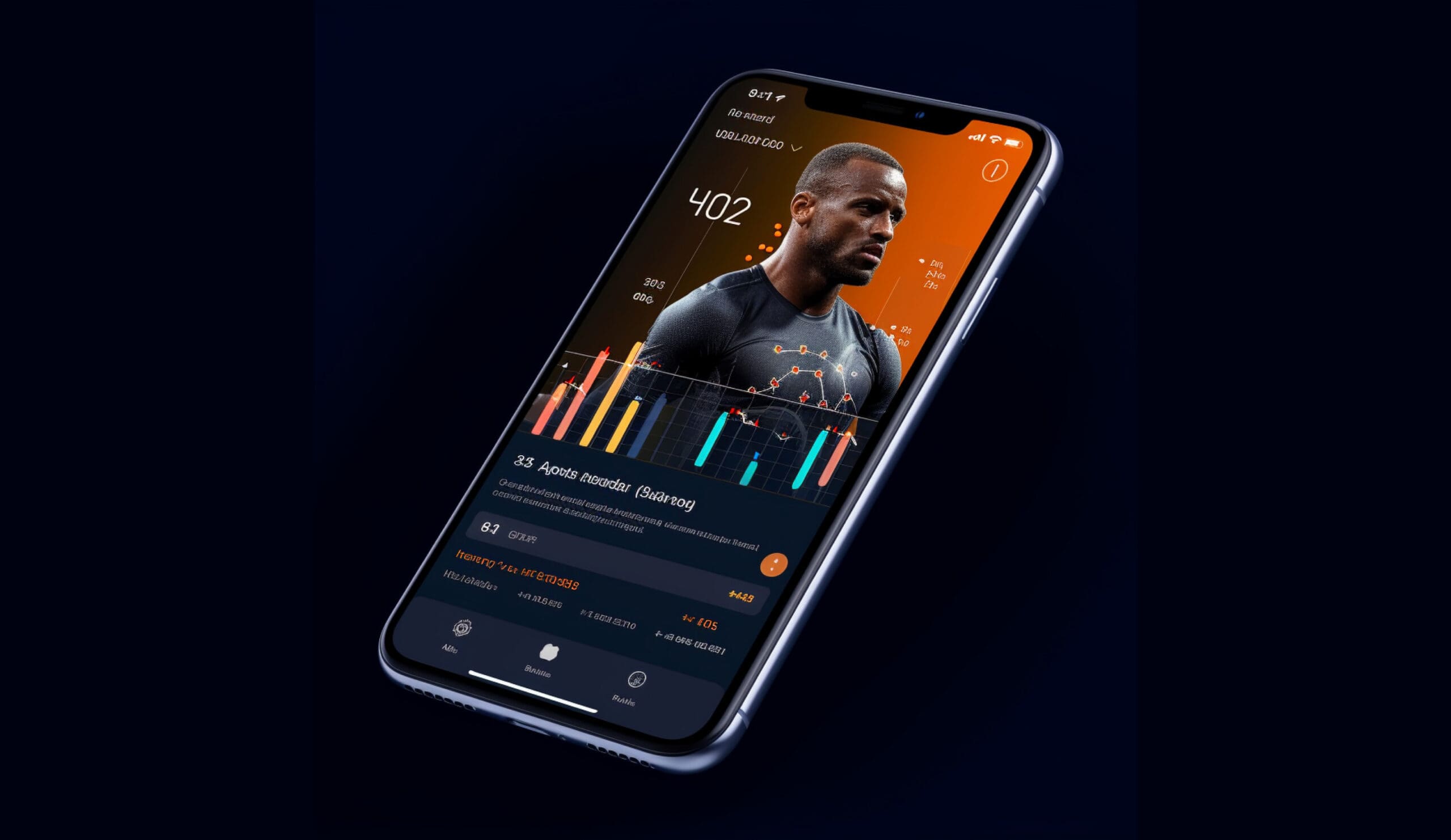
Contents
What is ball possession?
Ball possession in football refers to the amount of time a team controls the ball during a match. It’s not just about who has the ball more, it’s a key tactical metric that reflects a team’s ability to dictate the tempo, shape the flow of the game, and impose their playing style.
While having more possession doesn’t automatically guarantee victory, it often indicates which team is more dominant or better organised
Decoding possession: What the data reveals and who uses it
Ball possession data offers a window into the tactical battle unfolding on the pitch. It’s more than just a raw number; it’s a story told through the ebb and flow of control. But who’s listening to this story, and what are they learning?
– For analysts, ball possession percentages are a starting point. They dissect the data, looking beyond the headline figure to understand where possession is won and lost. Is a team dominating possession in harmless areas, or are they effectively controlling the ball in the opponent’s half, creating dangerous opportunities? This granular view allows analysts to identify tactical strengths and weaknesses, both for their own team and their opponents.
– Coaches use percentage of ball possession to assess the effectiveness of their game plan. Are their players following the intended style of play? Is the team maintaining possession in key areas? Possession stats can highlight areas where training might be needed, whether it’s improving passing accuracy, pressing effectiveness, or the ability to retain the ball under pressure.
– Scouts also pay close attention to possession data. They’re not just looking for players who can keep the ball; they’re looking for players who can use the ball effectively. Can a player retain possession in tight spaces? Can they make the key pass that unlocks a defence? Possession data, combined with other performance metrics, helps scouts identify players with the specific skill set a team needs.
– Even fans can gain a deeper appreciation for the game by understanding possession. It allows them to see beyond the scoreline and understand the tactical nuances of the match. Why is one team dominating? How is the other team trying to disrupt their flow? Possession data can add another layer of enjoyment and understanding to the viewing experience. I mean, who didn’t love Pep Guardiola’s 2009-2012 Barca team, as they gracefully dismantled every team in their way with intricate yet incisive possession?
Possession and beyond: Sportmonks’ data-driven insights
Sportmonks goes beyond simply tracking possession percentages. They understand that possession is a complex metric, and its true value lies in understanding how possession is gained, maintained, and used. That’s why they offer a range of data points that provide a more nuanced understanding of possession dynamics.
For example, Sportmonks tracks possession in different areas of the pitch. Possession in the attacking third is far more valuable than possession in your own defensive third. Sportmonks data allows analysts to see where teams are controlling the ball, revealing their intent and attacking threat. A team might have a high overall possession percentage, but if the majority of that possession is in their own half, it’s unlikely to translate into goals.
One of the most valuable aspects of Sportmonks’ data is the ability to connect possession to other key metrics. For instance, we offer a pressure index that measures the amount of pressure a team applies to their opponents when they have the ball. This metric helps analysts understand how teams are trying to win back possession and disrupt their opponent’s build-up play. A high pressure index coupled with a high opponent possession in their own third would suggest an effective pressing system.
By combining possession data with other metrics like pressure index, passing types, and location on the pitch, Sportmonks provides a much richer understanding of team performance.
They move beyond the simple question of who has the ball to explore how they use it, where they use it, and what they are trying to achieve.
The importance of ball possession
Ball possession is a significant aspect of football, although its importance can be debated. While it’s not the sole determinant of success, it can offer valuable insights into a team’s performance, tactical approach, and overall control of a match.
– Tactical implications: High ball possession often indicates a team’s intent to play a possession-based style of football. This approach typically involves building attacks patiently, controlling the tempo of the game, and attempting to create scoring opportunities through intricate passing sequences. Teams with high possession tend to have greater control over the flow of the match and can dictate the terms of engagement.
– Reflecting team style: Ball possession statistics can reflect a team’s overall playing style. Teams that prioritise possession often focus on technical proficiency, passing accuracy, and movement off the ball. Conversely, teams that have lower possession might favour a more direct, counter-attacking style, focusing on quick transitions and exploiting turnovers.
– Correlation with success (with caveats): There’s often a correlation between high possession and successful teams in football. Teams that dominate possession tend to have a greater chance of team success and winning matches. However, this is not always the case. Some teams can be very effective at winning matches despite having lower possession (ask Diego Simeone or Jose Mourinho), particularly those that are well-organised defensively and efficient on the counter-attack. The “possession is nine-tenths of the law” adage doesn’t always hold true in football.
– Control and dominance (but not always): High possession can indicate a team’s control and dominance in a match. By keeping the ball away from their opponents, they can limit the opposition’s scoring opportunities and increase their own chances of creating scoring opportunities. However, it’s important to remember that possession without purpose can be ineffective. Teams can have high possession but struggle to create clear-cut chances if they lack creativity or penetration in the final third.
– Defensive implications: While possession is often associated with attacking play, it can also have defensive benefits. By keeping the ball, a team can prevent their opponents from attacking. However, a team that focuses too much on keeping possession in their own defensive third can be vulnerable to high pressing and turnovers. Also, if a team spends too much time trying to keep the ball rather than finding the killer pass, they could get complacent in possession and start giving away sloppy chances.
– Context is key: It’s crucial to interpret ball possession statistics within the context of game situations. Factors such as the opponent’s playing style, the scoreline, and the match situation can all influence possession statistics. For example, when Atletico took a slender away goal lead (1-1) against FC Barcelona in the 2016 Champions league quarter finals, they knew they had to seal up at the back coming into the second leg and they did. They let Barca hold majority of the possession and for long spells and primely picked their moments to hit back. It eventually paid off as Koke gave them an aggregate lead which sent them into the semi finals.
Limitations of ball possession as a metric
While ball possession can offer valuable insights, it’s crucial to acknowledge its limitations as a standalone metric. Too much focus on ball possession can lead to misleading conclusions and a distorted view of a team’s performance. Here are some key limitations to consider:
– Possession without purpose: Increased attack efficiency does not have a direct relationship with ball possession . A team can dominate possession in their own defensive third or midfield without creating any meaningful scoring opportunities. “Sterile possession,” as it’s sometimes called, can be ineffective and even counterproductive if it doesn’t lead to positive outcomes.
– Defensive exposure: A team that focuses solely on keeping possession and making accurate passes can be vulnerable to counter-attacks. If they lose the ball in dangerous areas, they can be exposed defensively, even if they have had a high share of possession overall. A well-organised team can effectively defend against possession-based attacks and capitalise on turnovers.
– The match context is important: Possession statistics should always be interpreted within the context of the match. Factors such as the opponent’s playing style, the scoreline, and the match situation can all influence possession figures. For example, a team might have higher possession when they are chasing a game, while a team that is leading might be content to have less possession and focus on defending.
– Difference in playing styles: Different teams employ different playing styles, and some styles are inherently less possession-oriented than others. Teams that favour a direct, counter-attacking approach (like Nottingham Forest this season) might have lower possession but still be very effective at winning matches. Comparing possession statistics between teams with vastly different styles can be misleading.
– Individual skill vs. team play: Possession statistics often reflect team tactics and overall playing style, but they don’t always fully capture individual skill. A player might be highly effective at creating chances or making key passes even if their team has relatively low possession. Conversely, a player might have high possession but not contribute meaningfully to the team’s attacking play.
– Data collection variations: Different data providers may use slightly different methodologies for measuring and calculating possession, which can lead to minor variations in the reported figures. While the overall trend is usually consistent, it’s important to be aware of these variations when comparing data from different sources.
– Focus on the outcome: Ultimately, the most important thing in football is scoring goals and the match outcome (winning matches). While possession can be a helpful tool, it’s not the ultimate measure of success. A team can have low possession and still win if they are efficient in their attacks and well-organised defensively.
Ball possession in different playing styles
Ball possession plays a distinct role in various footballing philosophies and playing styles. Different approaches to the game emphasise possession to varying degrees, reflecting diverse tactical factors and priorities. Here’s a look at how possession manifests in some common playing styles:
– Possession-based styles (e.g., Tiki-Taka, Total Football): This style popularised by Johan Cruyff and Pep Guardiola heavily emphasise ball retention and more recently Manchester City in the English premier league. The aim is to control the game by dominating possession, building attacks patiently through intricate passing sequences, and creating scoring opportunities by wearing down the opposition. Teams employing these styles typically have very high possession percentages. The focus is on maintaining possession in the opponent’s half, creating overloads, and waiting for the right moment to penetrate the defence. Some ball possession-oriented teams that have thrived recently include, Arsenal, Barcelona, Atalanta and Bayern.
– Counter-attacking styles: Teams with a counter-attacking approach often prioritise defensive solidity and quick transitions. They may have gaps in ball possession, as their focus is on winning the ball back and launching rapid attacks before the opposition can get organised. These teams are often very efficient at converting turnovers into scoring chances. While they may not dominate possession, they can be highly effective at creating goalscoring opportunities. A team that had a high success rate in counters in the recent past was Manchester United.
– Direct/long-ball styles: Teams that favour a direct style often use long passes to bypass the midfield and quickly get the ball into attacking areas. Possession may be less of a priority, as the emphasis is on speed and directness. These teams might focus on winning aerial duels by fielding stronger taller players and creating direct attack chances from set-pieces or quick breaks. Possession is often sacrificed for the sake of rapid attacks. This pattern is also less likely to give the opposition an easy chance at your goal, as the ball is launched into the final third and prevents turnovers in dangerous areas. This pattern was implemented by Stoke City in the EPL 2010-2011 season.
– High-pressing styles: In recent history, this tactic has been popularized by Jurgen Klopp and known as Gegenpressing. Teams that employ a high-pressing style aim to win the ball back quickly in the opponent’s half which would lead to shots on target. While they may have periods of high possession, their primary focus is on disrupting the opposition’s build-up play and forcing turnovers. Possession is often a consequence of their pressing, rather than the primary objective. The aim is to regain possession high up the pitch and create scoring opportunities from these positions.
– Defensive/park-the-bus styles: A tactic commonly affiliated with Jose Mourinho as he has implemented it across multiple teams he has coached. Teams that prioritise a defensive approach may have low possession percentages, as their focus is on defending their own goal and frustrating the opposition, especially higher quality opposition. They may be content to concede possession and rely on counter-attacks or set-pieces to create scoring chances. Possession is often sacrificed in favour of defensive solidity and organisation. Teams that often use this style tend to be more optimistic in possession depending on the quality of opposition (i.e. against weaker teams).
The future of possession: A data-driven revolution
The story and analysis of ball possession is evolving. We’re moving beyond basic percentages to a deeper understanding of its dynamics, and Sportmonks is leading the charge. They’re not just measuring how much possession, but how it’s used. Where is it gained and lost? What passes are played? How does it create chances?
Sportmonks goes beyond simple possession percentages, offering granular data that reveals the context behind ball control. For example, they track possession in different zones of the pitch, distinguishing between harmless possession in your own half and dangerous possession in the attacking third. This allows analysts to understand not just how much a team has the ball, but where they have it, revealing their intent and attacking threat.
The future is about context. Sportmonks provides the data to understand why things happen, not just what. We’re helping you move beyond measurement to understanding possession’s true impact.
Sportmonks takes it further by keeping tabs on team moves with clear detail, showing who’s great at holding the ball or shining when it counts. With live game stats, possession spots, and simple numbers like pass success and shots taken, we show you each team’s style—whether they’re strong in defence or pushing forward. Pick the European Plan at €39 monthly for 27 leagues, the Worldwide Plan at €129 monthly for 111 leagues, the Enterprise Plan with custom pricing for over 2,200 leagues, or a Custom Plan made for your football interests, and you’ll see every play that matters. Check out the data at Sportmonks Football API Plans.
FAQs about ball possession
-
- Tactical control: High possession often indicates a team's intent to dictate the game's pace, build attacks methodically, and reduce the opponent's scoring chances.
- Style indicator: It reflects a team's playing philosophy, whether they favor a possession-based game or a direct, counter-attacking approach.
- Correlation with success: Teams with higher possession often have more opportunities to score, but there are exceptions where teams with less possession can win through efficiency or defensive solidity.
- Limitations: Possession must be purposeful; "sterile possession" without creating chances can be counterproductive. Also, a team overly focused on possession might be vulnerable to quick counter-attacks.
- Effective possession: When possession leads to attacking moves, creating chances, or scoring opportunities, usually in the opponent's half.
- Sterile possession: Possession that doesn't result in any significant threat or progression towards the opponent's goal, often in a team's own half or midfield without penetration.
- Possession in different zones: Possession can be analyzed by where it occurs on the pitch - defensive, midfield, or attacking thirds, each offering different strategic insights.
- Possession styles:
- Possession-based play: Emphasizing ball retention, like Tiki-Taka, where the aim is to wear down opponents with successful passes and high passing accuracy.
- Counter-attacking possession: Lower possession but higher efficiency when in possession, focusing on quick transitions from defense to attack.
- Direct play: Using long balls to bypass midfield, leading to brief spells of possession aimed at quick attacks.
- High-pressing possession: Gaining possession through aggressive pressing, often in the opponent's half to regain the ball and attack immediately.
- Defensive possession: Teams might hold onto the ball to manage the game, especially when leading, or to limit the opponent's attacking opportunities.


